Individual Assignment Solution: Financial Accounting & Reporting 1
VerifiedAdded on 2023/01/10
|7
|1908
|51
Homework Assignment
AI Summary
This document presents a comprehensive solution to a financial accounting assignment, addressing key issues related to intangible assets (patents) and the replacement of machinery. The solution meticulously explains the accounting treatment for patents, referencing AASB and IAS 38 standards, and outlining recognition criteria, initial recognition, amortization, and revaluation models. It also provides guidance on accounting for research and development costs and internally generated assets. Furthermore, the document explores methods for accounting for machinery replacement, specifically discussing the sinking fund method and the use of provisions. The solution is presented in the format of a business letter, offering professional advice to a client, and includes relevant references to support the arguments. This assignment aims to demonstrate the application of accounting principles and standards to real-world scenarios, showcasing an understanding of non-current assets and financial reporting.

ACCOUNTING AND FINANCIAL REPORTING
1
ACCOUNTING AND FINANCIAL
REPORTING
1
ACCOUNTING AND FINANCIAL
REPORTING
Paraphrase This Document
Need a fresh take? Get an instant paraphrase of this document with our AI Paraphraser
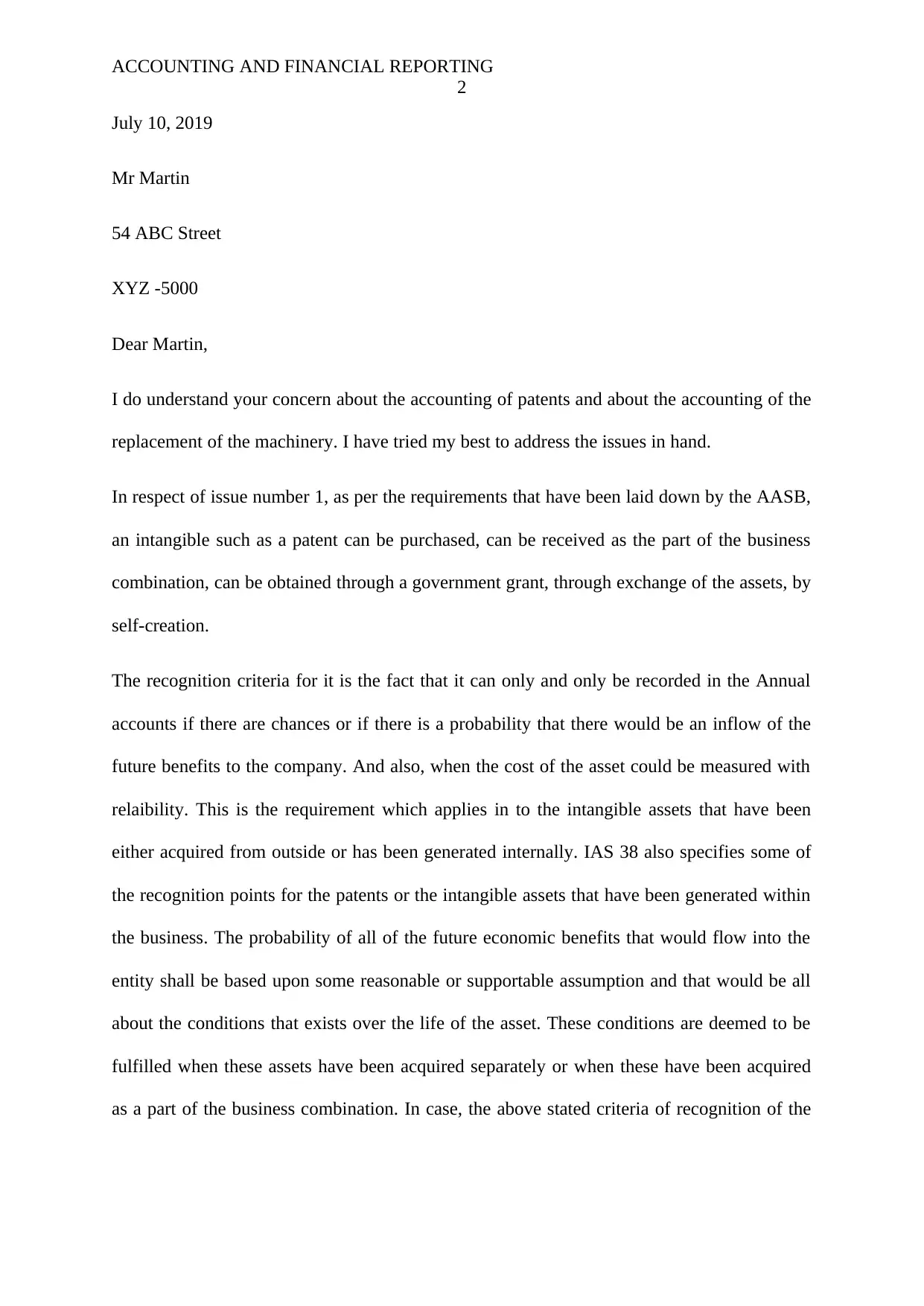
ACCOUNTING AND FINANCIAL REPORTING
2
July 10, 2019
Mr Martin
54 ABC Street
XYZ -5000
Dear Martin,
I do understand your concern about the accounting of patents and about the accounting of the
replacement of the machinery. I have tried my best to address the issues in hand.
In respect of issue number 1, as per the requirements that have been laid down by the AASB,
an intangible such as a patent can be purchased, can be received as the part of the business
combination, can be obtained through a government grant, through exchange of the assets, by
self-creation.
The recognition criteria for it is the fact that it can only and only be recorded in the Annual
accounts if there are chances or if there is a probability that there would be an inflow of the
future benefits to the company. And also, when the cost of the asset could be measured with
relaibility. This is the requirement which applies in to the intangible assets that have been
either acquired from outside or has been generated internally. IAS 38 also specifies some of
the recognition points for the patents or the intangible assets that have been generated within
the business. The probability of all of the future economic benefits that would flow into the
entity shall be based upon some reasonable or supportable assumption and that would be all
about the conditions that exists over the life of the asset. These conditions are deemed to be
fulfilled when these assets have been acquired separately or when these have been acquired
as a part of the business combination. In case, the above stated criteria of recognition of the
2
July 10, 2019
Mr Martin
54 ABC Street
XYZ -5000
Dear Martin,
I do understand your concern about the accounting of patents and about the accounting of the
replacement of the machinery. I have tried my best to address the issues in hand.
In respect of issue number 1, as per the requirements that have been laid down by the AASB,
an intangible such as a patent can be purchased, can be received as the part of the business
combination, can be obtained through a government grant, through exchange of the assets, by
self-creation.
The recognition criteria for it is the fact that it can only and only be recorded in the Annual
accounts if there are chances or if there is a probability that there would be an inflow of the
future benefits to the company. And also, when the cost of the asset could be measured with
relaibility. This is the requirement which applies in to the intangible assets that have been
either acquired from outside or has been generated internally. IAS 38 also specifies some of
the recognition points for the patents or the intangible assets that have been generated within
the business. The probability of all of the future economic benefits that would flow into the
entity shall be based upon some reasonable or supportable assumption and that would be all
about the conditions that exists over the life of the asset. These conditions are deemed to be
fulfilled when these assets have been acquired separately or when these have been acquired
as a part of the business combination. In case, the above stated criteria of recognition of the
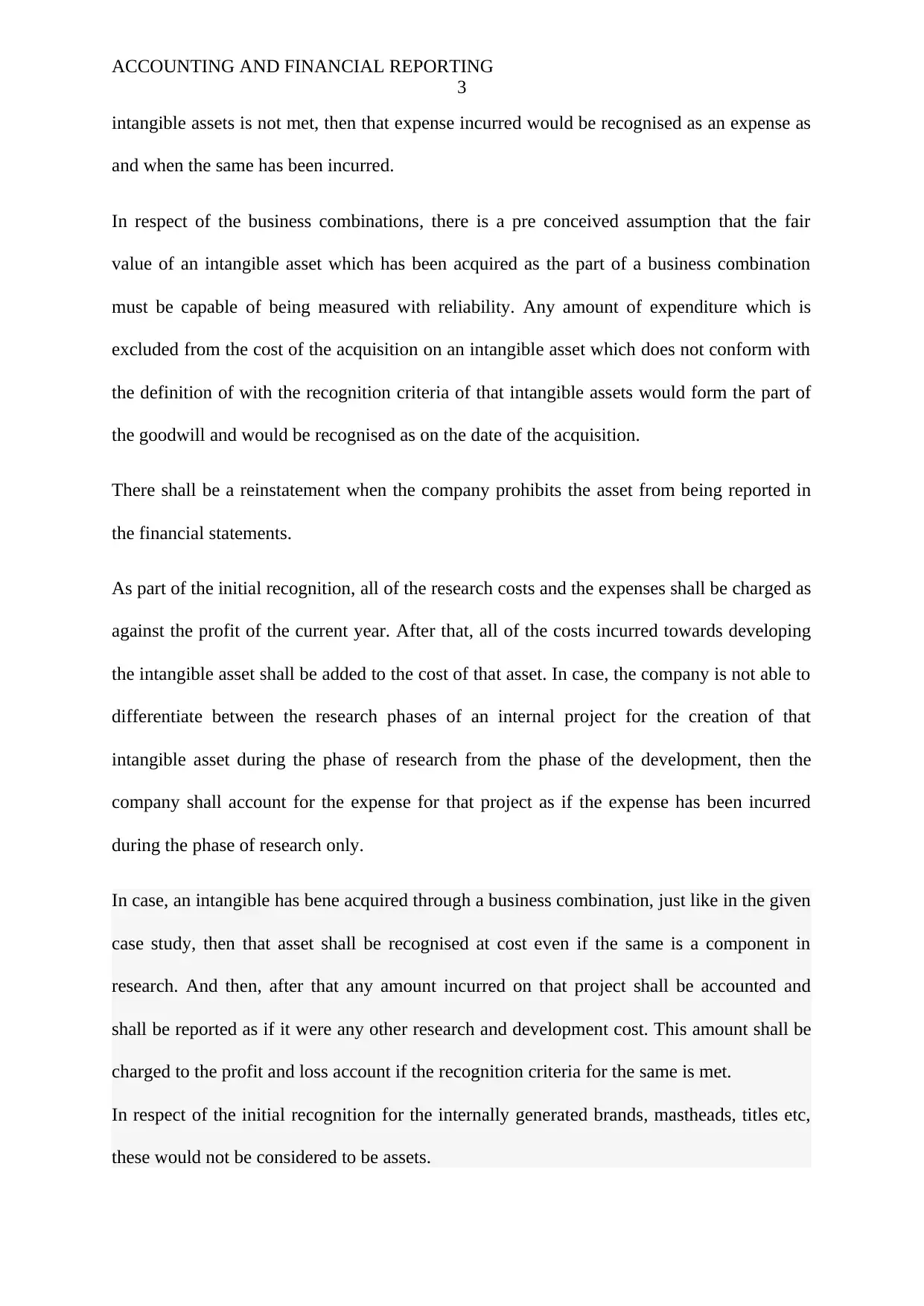
ACCOUNTING AND FINANCIAL REPORTING
3
intangible assets is not met, then that expense incurred would be recognised as an expense as
and when the same has been incurred.
In respect of the business combinations, there is a pre conceived assumption that the fair
value of an intangible asset which has been acquired as the part of a business combination
must be capable of being measured with reliability. Any amount of expenditure which is
excluded from the cost of the acquisition on an intangible asset which does not conform with
the definition of with the recognition criteria of that intangible assets would form the part of
the goodwill and would be recognised as on the date of the acquisition.
There shall be a reinstatement when the company prohibits the asset from being reported in
the financial statements.
As part of the initial recognition, all of the research costs and the expenses shall be charged as
against the profit of the current year. After that, all of the costs incurred towards developing
the intangible asset shall be added to the cost of that asset. In case, the company is not able to
differentiate between the research phases of an internal project for the creation of that
intangible asset during the phase of research from the phase of the development, then the
company shall account for the expense for that project as if the expense has been incurred
during the phase of research only.
In case, an intangible has bene acquired through a business combination, just like in the given
case study, then that asset shall be recognised at cost even if the same is a component in
research. And then, after that any amount incurred on that project shall be accounted and
shall be reported as if it were any other research and development cost. This amount shall be
charged to the profit and loss account if the recognition criteria for the same is met.
In respect of the initial recognition for the internally generated brands, mastheads, titles etc,
these would not be considered to be assets.
3
intangible assets is not met, then that expense incurred would be recognised as an expense as
and when the same has been incurred.
In respect of the business combinations, there is a pre conceived assumption that the fair
value of an intangible asset which has been acquired as the part of a business combination
must be capable of being measured with reliability. Any amount of expenditure which is
excluded from the cost of the acquisition on an intangible asset which does not conform with
the definition of with the recognition criteria of that intangible assets would form the part of
the goodwill and would be recognised as on the date of the acquisition.
There shall be a reinstatement when the company prohibits the asset from being reported in
the financial statements.
As part of the initial recognition, all of the research costs and the expenses shall be charged as
against the profit of the current year. After that, all of the costs incurred towards developing
the intangible asset shall be added to the cost of that asset. In case, the company is not able to
differentiate between the research phases of an internal project for the creation of that
intangible asset during the phase of research from the phase of the development, then the
company shall account for the expense for that project as if the expense has been incurred
during the phase of research only.
In case, an intangible has bene acquired through a business combination, just like in the given
case study, then that asset shall be recognised at cost even if the same is a component in
research. And then, after that any amount incurred on that project shall be accounted and
shall be reported as if it were any other research and development cost. This amount shall be
charged to the profit and loss account if the recognition criteria for the same is met.
In respect of the initial recognition for the internally generated brands, mastheads, titles etc,
these would not be considered to be assets.
⊘ This is a preview!⊘
Do you want full access?
Subscribe today to unlock all pages.

Trusted by 1+ million students worldwide
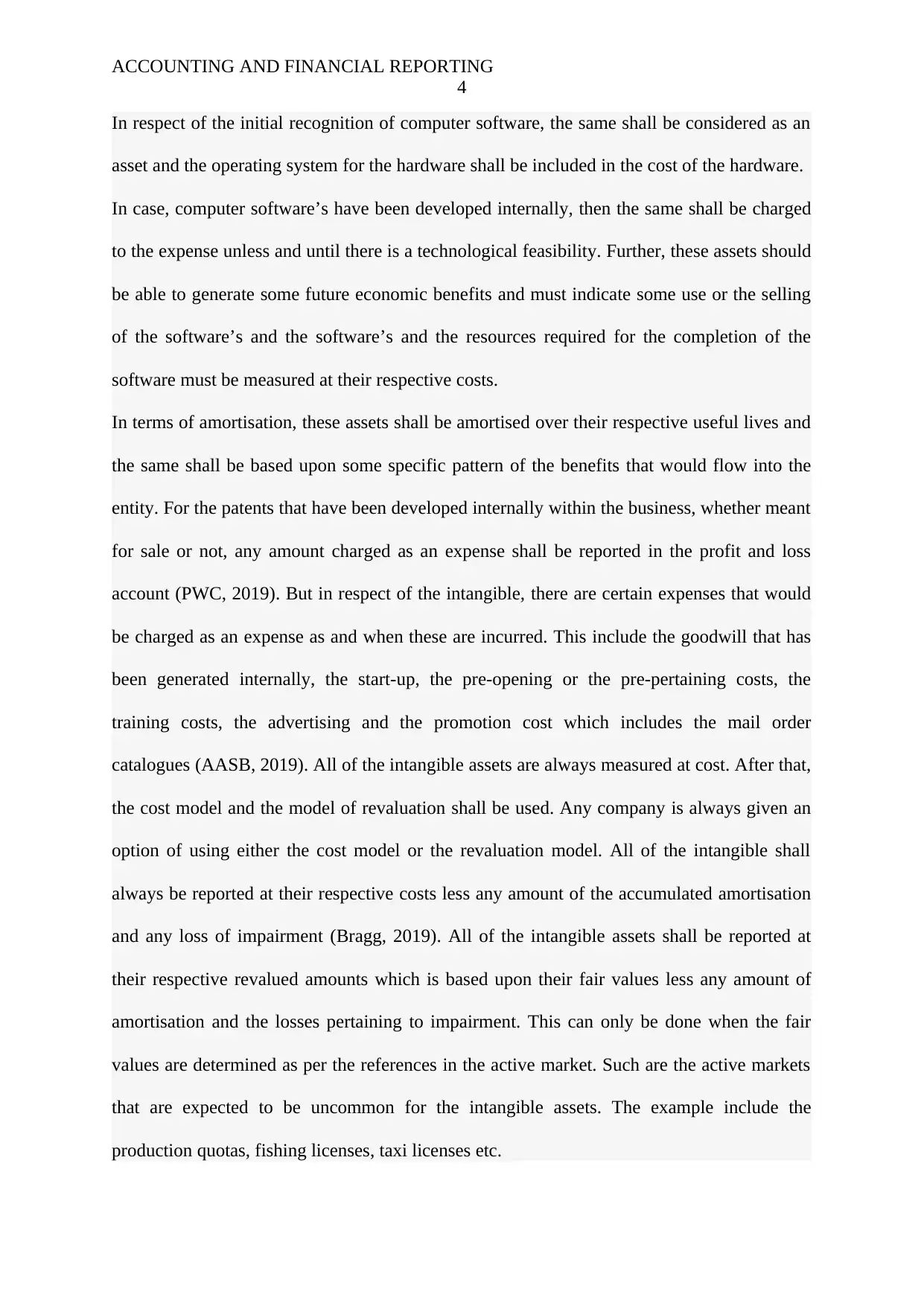
ACCOUNTING AND FINANCIAL REPORTING
4
In respect of the initial recognition of computer software, the same shall be considered as an
asset and the operating system for the hardware shall be included in the cost of the hardware.
In case, computer software’s have been developed internally, then the same shall be charged
to the expense unless and until there is a technological feasibility. Further, these assets should
be able to generate some future economic benefits and must indicate some use or the selling
of the software’s and the software’s and the resources required for the completion of the
software must be measured at their respective costs.
In terms of amortisation, these assets shall be amortised over their respective useful lives and
the same shall be based upon some specific pattern of the benefits that would flow into the
entity. For the patents that have been developed internally within the business, whether meant
for sale or not, any amount charged as an expense shall be reported in the profit and loss
account (PWC, 2019). But in respect of the intangible, there are certain expenses that would
be charged as an expense as and when these are incurred. This include the goodwill that has
been generated internally, the start-up, the pre-opening or the pre-pertaining costs, the
training costs, the advertising and the promotion cost which includes the mail order
catalogues (AASB, 2019). All of the intangible assets are always measured at cost. After that,
the cost model and the model of revaluation shall be used. Any company is always given an
option of using either the cost model or the revaluation model. All of the intangible shall
always be reported at their respective costs less any amount of the accumulated amortisation
and any loss of impairment (Bragg, 2019). All of the intangible assets shall be reported at
their respective revalued amounts which is based upon their fair values less any amount of
amortisation and the losses pertaining to impairment. This can only be done when the fair
values are determined as per the references in the active market. Such are the active markets
that are expected to be uncommon for the intangible assets. The example include the
production quotas, fishing licenses, taxi licenses etc.
4
In respect of the initial recognition of computer software, the same shall be considered as an
asset and the operating system for the hardware shall be included in the cost of the hardware.
In case, computer software’s have been developed internally, then the same shall be charged
to the expense unless and until there is a technological feasibility. Further, these assets should
be able to generate some future economic benefits and must indicate some use or the selling
of the software’s and the software’s and the resources required for the completion of the
software must be measured at their respective costs.
In terms of amortisation, these assets shall be amortised over their respective useful lives and
the same shall be based upon some specific pattern of the benefits that would flow into the
entity. For the patents that have been developed internally within the business, whether meant
for sale or not, any amount charged as an expense shall be reported in the profit and loss
account (PWC, 2019). But in respect of the intangible, there are certain expenses that would
be charged as an expense as and when these are incurred. This include the goodwill that has
been generated internally, the start-up, the pre-opening or the pre-pertaining costs, the
training costs, the advertising and the promotion cost which includes the mail order
catalogues (AASB, 2019). All of the intangible assets are always measured at cost. After that,
the cost model and the model of revaluation shall be used. Any company is always given an
option of using either the cost model or the revaluation model. All of the intangible shall
always be reported at their respective costs less any amount of the accumulated amortisation
and any loss of impairment (Bragg, 2019). All of the intangible assets shall be reported at
their respective revalued amounts which is based upon their fair values less any amount of
amortisation and the losses pertaining to impairment. This can only be done when the fair
values are determined as per the references in the active market. Such are the active markets
that are expected to be uncommon for the intangible assets. The example include the
production quotas, fishing licenses, taxi licenses etc.
Paraphrase This Document
Need a fresh take? Get an instant paraphrase of this document with our AI Paraphraser
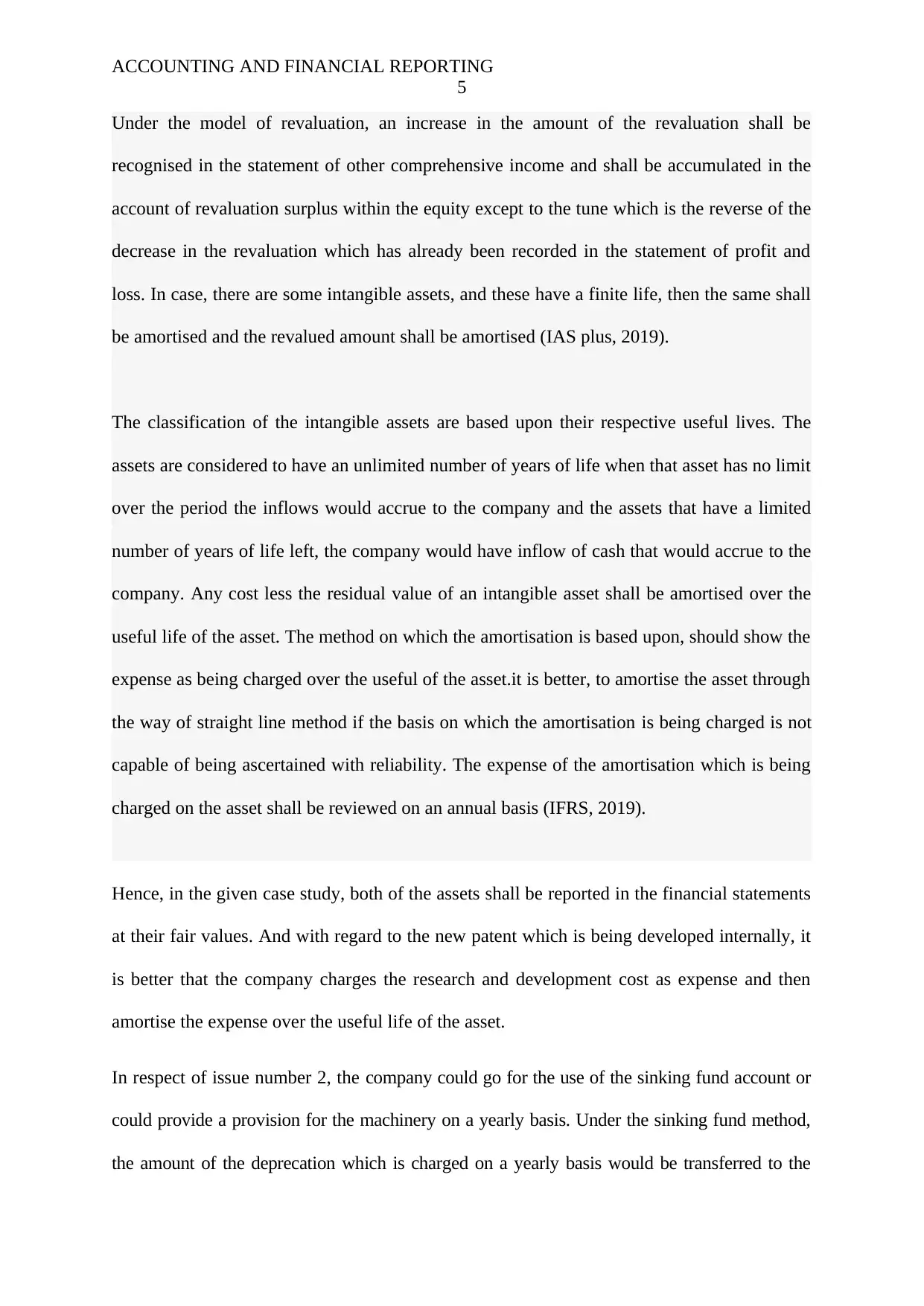
ACCOUNTING AND FINANCIAL REPORTING
5
Under the model of revaluation, an increase in the amount of the revaluation shall be
recognised in the statement of other comprehensive income and shall be accumulated in the
account of revaluation surplus within the equity except to the tune which is the reverse of the
decrease in the revaluation which has already been recorded in the statement of profit and
loss. In case, there are some intangible assets, and these have a finite life, then the same shall
be amortised and the revalued amount shall be amortised (IAS plus, 2019).
The classification of the intangible assets are based upon their respective useful lives. The
assets are considered to have an unlimited number of years of life when that asset has no limit
over the period the inflows would accrue to the company and the assets that have a limited
number of years of life left, the company would have inflow of cash that would accrue to the
company. Any cost less the residual value of an intangible asset shall be amortised over the
useful life of the asset. The method on which the amortisation is based upon, should show the
expense as being charged over the useful of the asset.it is better, to amortise the asset through
the way of straight line method if the basis on which the amortisation is being charged is not
capable of being ascertained with reliability. The expense of the amortisation which is being
charged on the asset shall be reviewed on an annual basis (IFRS, 2019).
Hence, in the given case study, both of the assets shall be reported in the financial statements
at their fair values. And with regard to the new patent which is being developed internally, it
is better that the company charges the research and development cost as expense and then
amortise the expense over the useful life of the asset.
In respect of issue number 2, the company could go for the use of the sinking fund account or
could provide a provision for the machinery on a yearly basis. Under the sinking fund method,
the amount of the deprecation which is charged on a yearly basis would be transferred to the
5
Under the model of revaluation, an increase in the amount of the revaluation shall be
recognised in the statement of other comprehensive income and shall be accumulated in the
account of revaluation surplus within the equity except to the tune which is the reverse of the
decrease in the revaluation which has already been recorded in the statement of profit and
loss. In case, there are some intangible assets, and these have a finite life, then the same shall
be amortised and the revalued amount shall be amortised (IAS plus, 2019).
The classification of the intangible assets are based upon their respective useful lives. The
assets are considered to have an unlimited number of years of life when that asset has no limit
over the period the inflows would accrue to the company and the assets that have a limited
number of years of life left, the company would have inflow of cash that would accrue to the
company. Any cost less the residual value of an intangible asset shall be amortised over the
useful life of the asset. The method on which the amortisation is based upon, should show the
expense as being charged over the useful of the asset.it is better, to amortise the asset through
the way of straight line method if the basis on which the amortisation is being charged is not
capable of being ascertained with reliability. The expense of the amortisation which is being
charged on the asset shall be reviewed on an annual basis (IFRS, 2019).
Hence, in the given case study, both of the assets shall be reported in the financial statements
at their fair values. And with regard to the new patent which is being developed internally, it
is better that the company charges the research and development cost as expense and then
amortise the expense over the useful life of the asset.
In respect of issue number 2, the company could go for the use of the sinking fund account or
could provide a provision for the machinery on a yearly basis. Under the sinking fund method,
the amount of the deprecation which is charged on a yearly basis would be transferred to the
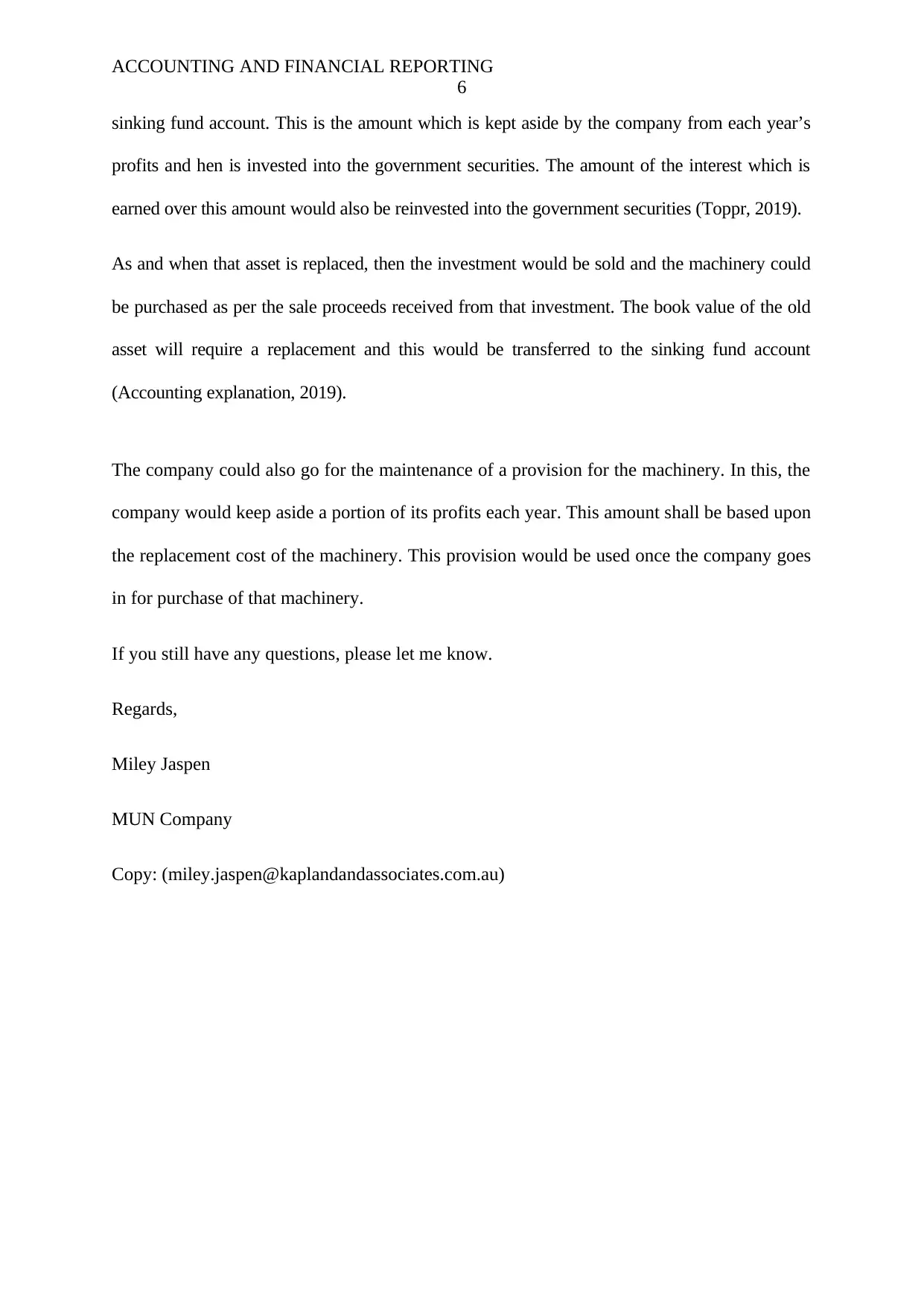
ACCOUNTING AND FINANCIAL REPORTING
6
sinking fund account. This is the amount which is kept aside by the company from each year’s
profits and hen is invested into the government securities. The amount of the interest which is
earned over this amount would also be reinvested into the government securities (Toppr, 2019).
As and when that asset is replaced, then the investment would be sold and the machinery could
be purchased as per the sale proceeds received from that investment. The book value of the old
asset will require a replacement and this would be transferred to the sinking fund account
(Accounting explanation, 2019).
The company could also go for the maintenance of a provision for the machinery. In this, the
company would keep aside a portion of its profits each year. This amount shall be based upon
the replacement cost of the machinery. This provision would be used once the company goes
in for purchase of that machinery.
If you still have any questions, please let me know.
Regards,
Miley Jaspen
MUN Company
Copy: (miley.jaspen@kaplandandassociates.com.au)
6
sinking fund account. This is the amount which is kept aside by the company from each year’s
profits and hen is invested into the government securities. The amount of the interest which is
earned over this amount would also be reinvested into the government securities (Toppr, 2019).
As and when that asset is replaced, then the investment would be sold and the machinery could
be purchased as per the sale proceeds received from that investment. The book value of the old
asset will require a replacement and this would be transferred to the sinking fund account
(Accounting explanation, 2019).
The company could also go for the maintenance of a provision for the machinery. In this, the
company would keep aside a portion of its profits each year. This amount shall be based upon
the replacement cost of the machinery. This provision would be used once the company goes
in for purchase of that machinery.
If you still have any questions, please let me know.
Regards,
Miley Jaspen
MUN Company
Copy: (miley.jaspen@kaplandandassociates.com.au)
⊘ This is a preview!⊘
Do you want full access?
Subscribe today to unlock all pages.

Trusted by 1+ million students worldwide
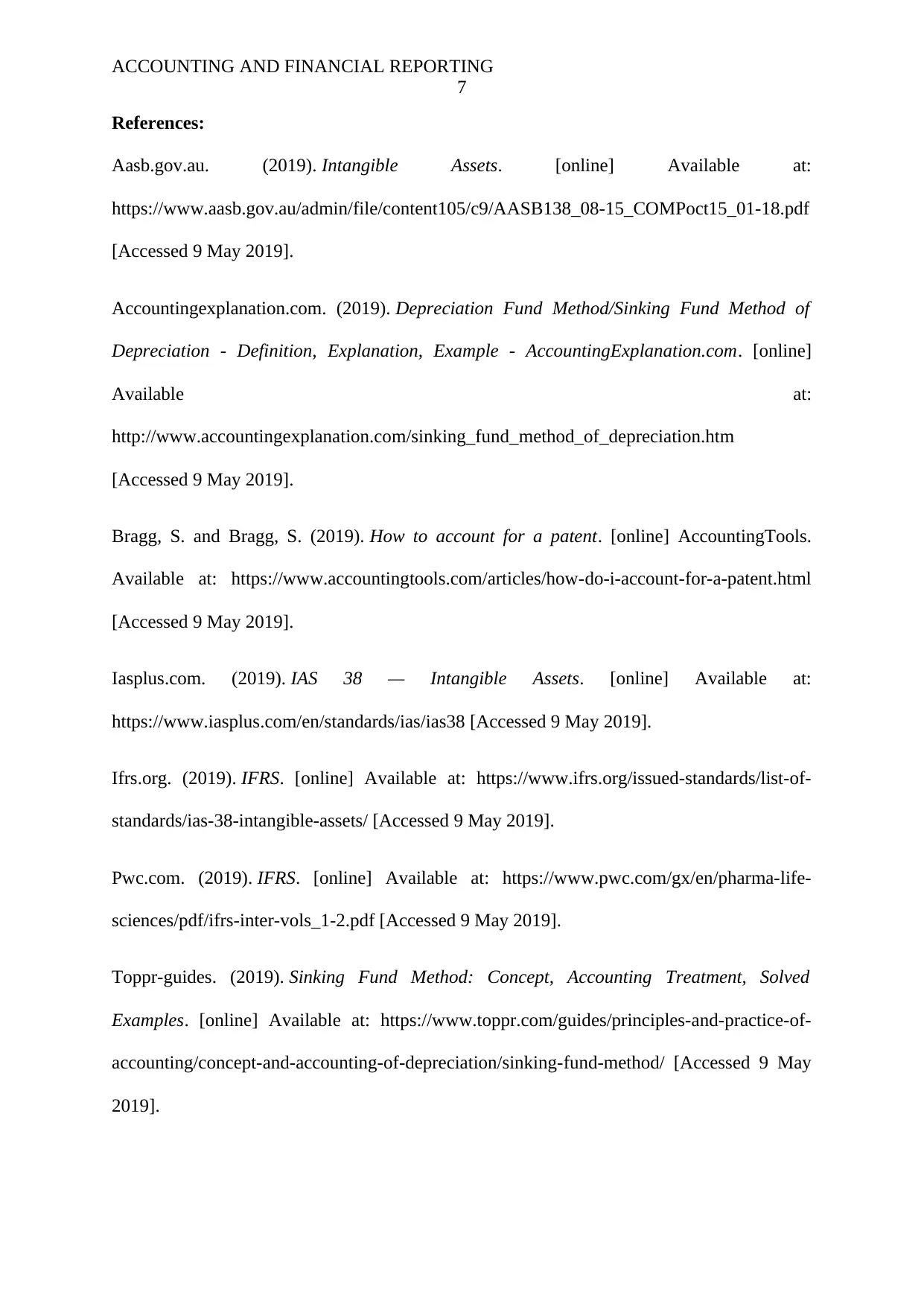
ACCOUNTING AND FINANCIAL REPORTING
7
References:
Aasb.gov.au. (2019). Intangible Assets. [online] Available at:
https://www.aasb.gov.au/admin/file/content105/c9/AASB138_08-15_COMPoct15_01-18.pdf
[Accessed 9 May 2019].
Accountingexplanation.com. (2019). Depreciation Fund Method/Sinking Fund Method of
Depreciation - Definition, Explanation, Example - AccountingExplanation.com. [online]
Available at:
http://www.accountingexplanation.com/sinking_fund_method_of_depreciation.htm
[Accessed 9 May 2019].
Bragg, S. and Bragg, S. (2019). How to account for a patent. [online] AccountingTools.
Available at: https://www.accountingtools.com/articles/how-do-i-account-for-a-patent.html
[Accessed 9 May 2019].
Iasplus.com. (2019). IAS 38 — Intangible Assets. [online] Available at:
https://www.iasplus.com/en/standards/ias/ias38 [Accessed 9 May 2019].
Ifrs.org. (2019). IFRS. [online] Available at: https://www.ifrs.org/issued-standards/list-of-
standards/ias-38-intangible-assets/ [Accessed 9 May 2019].
Pwc.com. (2019). IFRS. [online] Available at: https://www.pwc.com/gx/en/pharma-life-
sciences/pdf/ifrs-inter-vols_1-2.pdf [Accessed 9 May 2019].
Toppr-guides. (2019). Sinking Fund Method: Concept, Accounting Treatment, Solved
Examples. [online] Available at: https://www.toppr.com/guides/principles-and-practice-of-
accounting/concept-and-accounting-of-depreciation/sinking-fund-method/ [Accessed 9 May
2019].
7
References:
Aasb.gov.au. (2019). Intangible Assets. [online] Available at:
https://www.aasb.gov.au/admin/file/content105/c9/AASB138_08-15_COMPoct15_01-18.pdf
[Accessed 9 May 2019].
Accountingexplanation.com. (2019). Depreciation Fund Method/Sinking Fund Method of
Depreciation - Definition, Explanation, Example - AccountingExplanation.com. [online]
Available at:
http://www.accountingexplanation.com/sinking_fund_method_of_depreciation.htm
[Accessed 9 May 2019].
Bragg, S. and Bragg, S. (2019). How to account for a patent. [online] AccountingTools.
Available at: https://www.accountingtools.com/articles/how-do-i-account-for-a-patent.html
[Accessed 9 May 2019].
Iasplus.com. (2019). IAS 38 — Intangible Assets. [online] Available at:
https://www.iasplus.com/en/standards/ias/ias38 [Accessed 9 May 2019].
Ifrs.org. (2019). IFRS. [online] Available at: https://www.ifrs.org/issued-standards/list-of-
standards/ias-38-intangible-assets/ [Accessed 9 May 2019].
Pwc.com. (2019). IFRS. [online] Available at: https://www.pwc.com/gx/en/pharma-life-
sciences/pdf/ifrs-inter-vols_1-2.pdf [Accessed 9 May 2019].
Toppr-guides. (2019). Sinking Fund Method: Concept, Accounting Treatment, Solved
Examples. [online] Available at: https://www.toppr.com/guides/principles-and-practice-of-
accounting/concept-and-accounting-of-depreciation/sinking-fund-method/ [Accessed 9 May
2019].
1 out of 7
Related Documents
Your All-in-One AI-Powered Toolkit for Academic Success.
+13062052269
info@desklib.com
Available 24*7 on WhatsApp / Email
![[object Object]](/_next/static/media/star-bottom.7253800d.svg)
Unlock your academic potential
Copyright © 2020–2025 A2Z Services. All Rights Reserved. Developed and managed by ZUCOL.





